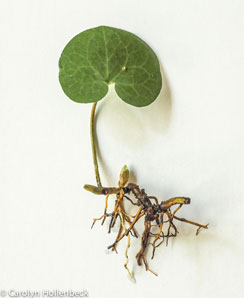 While no trace of the lovely mottled Asarum shuttleworthii (noted on Beatrix Farrand’s original plan) has been observed in the Entrance Garden to date, a hardier species, Asaurm europaeum now grows there in abundance. We have no clues to indicate whether or not Farrand made this substitution herself or if A. europaeum was planted by another property owner years later. After rehabilitation of the garden,both species will grow together in the little garden.
While no trace of the lovely mottled Asarum shuttleworthii (noted on Beatrix Farrand’s original plan) has been observed in the Entrance Garden to date, a hardier species, Asaurm europaeum now grows there in abundance. We have no clues to indicate whether or not Farrand made this substitution herself or if A. europaeum was planted by another property owner years later. After rehabilitation of the garden,both species will grow together in the little garden.
Commonly called European Wild Ginger, hazelnut and asarabacca, Asarum europaeum has been cultivated as a medicinal herb since the thirteenth century. Native to Europe, it can be found growing in calcareous soils and open woodlands from Russia to Finland, south to Sweden, the United Kingdom and France. Asarum europaeum is a slow growing plant 4 – 6” in height, spreading 6 to 8”. Kidney shaped leaves with a peppery-like smell, are opposite and born on a short, fleshy stem. One drooping dusky purple flower, hidden under the leaves, appears in 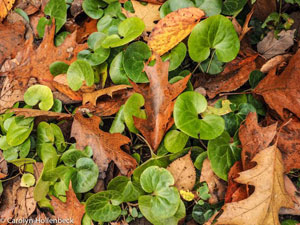 the spring. Hemaphroditic flowers are pollinated by beetles and bees as well as small flies. Once established A. europaeum is self sowing although additional propagation is possible by sowing seed in a cold frame or dividing the rhizomes early in early spring. Mulching with leaf mold or garden compost will help to maintain fertility.
the spring. Hemaphroditic flowers are pollinated by beetles and bees as well as small flies. Once established A. europaeum is self sowing although additional propagation is possible by sowing seed in a cold frame or dividing the rhizomes early in early spring. Mulching with leaf mold or garden compost will help to maintain fertility.
While rust, leaf gall,snails and slugs may cause problems for these plants, the beautiful glossy, evergreen leaves may outweigh any concerns one may have over issues that may be encountered. The texture and form of European ginger which combines well with with miniature Hosta and short ferns makes A. europaeuma the perfect ground cover for shady or dappled shade sites. These features alone could tempt a gardener in search of an eye-catching ground cover to add Asaurm europium to their own landscape.
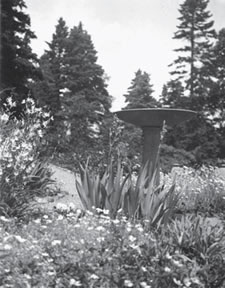 Beatrix Farrand Society Archives” width=”225″ height=”288″ data-id=”1107″> Iris at Reef Point, 1930s
Beatrix Farrand Society Archives” width=”225″ height=”288″ data-id=”1107″> Iris at Reef Point, 1930sBeatrix Farrand Society Archives
A vintage black-and-white photograph taken at Reef Point shows Bearded Iris clustered around a tall birdbath. During the Terrace Garden restoration, dense clumps of iris were discovered in some of the beds and alongside the walls of the study, all struggling for survival. After a season in the holding garden, these irises bloomed once again to reveal nine different cultivars. Samples from four different cultivars found at Garland Farm have been sent to the Historical Iris Preservation Society for identification in the hope that they may be progeny from Reef Point.
Iris belongs to the Iridaceae family and for centuries their flowers were used for medicinal purposes as well as for flavoring wine and spirits. Iris was the rainbow goddess in Greek mythology who, as a messenger between the heavens and earth, left a trail of glittering color behind her.The earliest known depiction of an iris appears in a wall fresco in the Minoan palace of Knossos, on the Greek island of Crete (2100 BC).
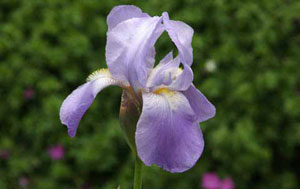
Bearded Iris, classified by the height of the flower stalk, ranges from miniature (8″ or less) to tall (27″ or more). All have an underground stem or rhizome from which anchoring roots, flower stalks, and spear-shaped leaves arise. The flowers consist of 6 petals: 3 drooping outer petals (falls) and 3 inner petals (standards). Bristly hairs or beards act as a nectar guide for pollinating insects. A pollen-bearing anther is located under a style arm and under each arm is a stigmatic surface on which pollens collects before fertilization. An ovary is located at the base of the flower and surrounded by a green sheath.
Irises prefer a sunny location with well-drained soil (pH 6-7) and the rhizomes should be planted at ground level because baking in the sun promotes flowering. In the spring, apply bone meal or a low-nitrogen fertilizer (5-10-10). Rhizomes should be divided every three or four years after flowering when they are dormant. Although hardy and relatively easy to grow, iris borer, bacterial and fungal leaf-spot, and fungal rot of the rhizome may be problematic. Fungal and bacterial issues are most prevalent in wet weather or when suffering from overwatering.
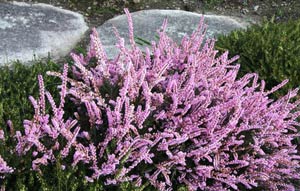
Two articles in the Reef Point Gardens Bulletins, as well as two large beds of heather in the center of the Terrace Garden, illustrate the importance of this plant to Beatrix Farrand. Gazing out at the garden from the Farrand wing, the Walter wing, or the study provides wonderful views of these lovely plants.
Originating in Europe, heather was used during the Iron Age by the Picts to make mead. Plants were also used for medicinal purposes as well as for fuel and for making brooms, thatch, and rope. White heather was traditionally considered good luck. After years of being overlooked in ornamental gardens, heather came back into fashion through the efforts of William Robinson, who popularized “wild” plants in the second half of the nineteenth century in his book, The Wild Garden.
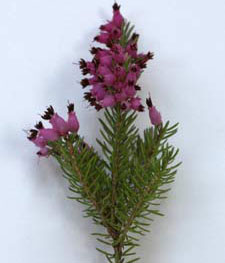 Carolyn Hollenbeck” width=”225″ height=”263″ data-id=”1106″> Erica sp. Carolyn Hollenbeck
Carolyn Hollenbeck” width=”225″ height=”263″ data-id=”1106″> Erica sp. Carolyn HollenbeckBelonging to the family Ericaceae, three genera comprise what are often referred to as “heather”: Calluna (true heather), with small scale-like leaves; Erica (heath), with needle-like leaves and delicate root systems; and Daboecia (St. Dabeoc’s heath), less hardy with slightly broader, alternate needle-like leaves. All are evergreen shrubs that may be upright or form mats. These plants do best in sunny, well-drained open areas, with acidic soils (pH 5.0-5.5) enriched with organic matter. Suitable for raised beds or containers, they are best grown in drifts.
Propagate heathers from seed, midsummer cuttings, or by layering or dropping. For best flowering, prune Calluna in the spring in colder areas and Erica after the blooms have faded. Cultivars with colorful spring tips should be pruned before new growth begins. Transplanting is not recommended for older plants and as hardiness varies, winter protection should be provided in colder areas. Fungal diseases may be problematic, but as heathers offer year-round color and interest, they are well worth considering for the home landscape.

Early in April, evidence of the return of spring can be found in the Terrace Garden, not only with the blooming of early heaths, but by the swelling of buds on two Clematis ‘Jackmanii’. Other clematis in the garden—C. viticella, C. montana, C. texensis, and the herbaceous C. integrifolia—also show signs that a new season is beginning.
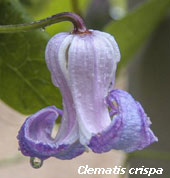
The name Clematis comes from the Greek (klema), meaning vine branch or vine-like. Although early plant collectors brought back specimens of C. viticella to England from Spain (1569), little interest in the plants existed until the 19th century when large-flowered specimens were introduced from China and Japan. Many cultivars that were hybridized then remain popular today. Clematis varies greatly in form, color, and bloom season. Although mostly woody, deciduous climbers, a few are herbaceous. Flowers have 4 to 8 colorful sepals, but no true petals, which may be small, white flowers in panicles, bell- or urn-shaded, and flat or open. Fruits are ball-shaped or feathery. Leaves are opposite with 3 to 5 leaflets. Full sun and well-drained soil provide the best growing conditions.
Pruning clematis is a concern for many gardeners. Early-flowering clematis bloom on old wood and should be pruned after flowering. For large-flowering cultivars blooming on old or new wood, an annual grooming without severe pruning is recommended. Late large-flowering varieties bloom only on new wood and should be cut back in early spring to two strong sets of buds on each stem. Although Clematis Wilt remains an issue, the sight of clematis in a pot, winding through a tree, or growing up a trellis may provide enough inspiration for any gardener to include one or more in their own plant collection.
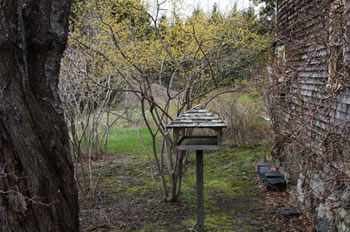
At Garland Farm, two champion Cornus mas (Cornelian Cherry Dogwood) are tucked behind the barn. Covered with yellow flower clusters in the spring and bright-red fruit in the late summer, these beautiful trees possess lovely, exfoliating bark and are sure to delight any visitor regardless of the time of year.
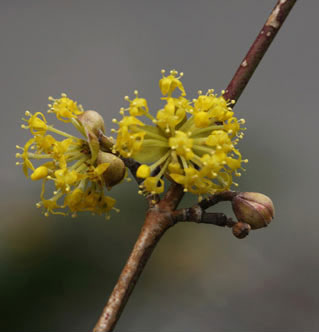
Native to Central and Southern Europe, as well as Western Asia, Cornus mas makes a wonderful addition to any home landscape. They require full sun or partial shade and are tolerant of a wide range of soils and pH (5.0 to 7.5). Cornelian Cherry Dogwood can be grown as a small tree or multi-stemmed shrub, either as single specimen or as a hedge. The bark is an attractive mixture of gray and tan. New stem growth is green, becoming reddish-brown to purple on top, but remaining green on the bottom as the season progres. Bi-coloration persists until the following spring.
Llate March or early April, showy bright yellow flower clusters, attached to nodes of first-year wood or short spur shoots on older wood, burst from small, globular, pendulous bulbs, heralding the arrival of spring. Glossy dark green leaves that are opposite, simple, and elliptic appear after the blooms have faded. Immature green fruits, containing a small drupe, turn red in July and are edible when their color becomes dark maroon. Fruits have an acidic flavor that has been described as a mixture of cranberry and sour cherry.
Cornus mas responds well to pruning and is best limbed-up, as branching to the ground tends to hide the bark and prevent turf growth if planted near lawns. Usually pest and disease resistant, leaf miners, borers, and cankers may be problematic. Cornelian Dogwood Cherry is adaptable to heat and drought, it is ozone tolerant, resistant to breakage, attractive to wildlife, and beautiful to look at regardless of the season.
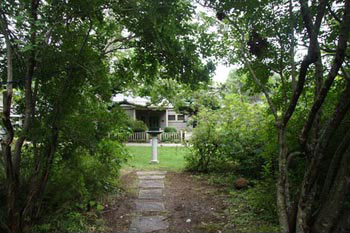
When visitors cross the north field parking area leading to the entrance to Garland Farm, they immediately notice an arch formed by two stately Enkianthus campanulatus flanking the stone path through the wild garden to the Lunaform birdbath. On a spring day, masses of tiny bell-shaped flowers can be seen hanging from the tips of twigs. The shiny green foliage provides shade on a warm summer day and turns a dazzling shade of red in the fall. Layered branching, visible in the winter, makes this slow-growing shrub a lovely sight any time of the year.
Enkianthus campanulatus is a member of the Ericaceae (heath) family, along with Rhododendron, Pieris, heather, blueberry, and cranberry. Often referred to as Redvein Enkianthus, the Japanese native is an upright and deciduous shrub named for its pendulous clusters of bell-shaped flowers. Enkianthus takes its name from two Greek words meaning “swollen,” while campanulatus is Latin for “bell shaped.” Redvein describes the appearance of the cream-colored flowers with little red lines.

Redvein Enkianthus can be used in the landscape as a single specimen, in groups, or trained as a small tree. Reaching a height of 6 to 12 feet and a width of 4 to 6 feet, this shrub has an oval form at maturity, with a layered branching habit. Bark on new shoots has a reddish coloration. The foliage, resembling that of Rhododendron leaves, may also appear layered, and leaf clusters are attached to twig tips by red petioles. Leaves are alternate, 1” to 3” long and up to 1” wide, and are elliptical in shape, with bristly teeth along the margins. Bristles may be found on the leaf surface also. Summer color ranges from medium green to bluish green, turning to spectacular shades of red, orange, or yellow in the fall. Although flowers of Enkianthus campanulatus bloom as early as May in some areas, at Garland Farm they open in early June. This year the shrubs were covered with pendulous clusters of these delicate, creamy bells. Tiny yellow stamens are tucked inside of the red-veined corolla with red tips. Fruits are small brown capsules that add no ornamental value to the shrub.
This four-season shrub looks well with other members of the Ericaceae family. Hardy in zones 5A to 7B, it grows best in cool, well-drained soil that is moist, acidic (pH range of 4.5 to 6.0), and rich in organic matter. It requires full sun to partial shade, but hot, dry sites should be avoided. Pruning is usually unnecessary as offset branches add to the winter interest. Plants do well if mulched to keep the roots cool and feeding after the bloom cycle is recommended. Propagation can easily be done from seed, softwood cuttings, or tissue culture, although plants grown from seed may not have red fall color. To maximize enjoyment of this plant, it should be sited with the flowers, foliage, and branching easily seen throughout the year.
 Pressley Associates, Inc.” width=”288″ height=”196″ data-id=”1137″> Front garden adjacent to barn, 2006 Pressley Associates, Inc.
Pressley Associates, Inc.” width=”288″ height=”196″ data-id=”1137″> Front garden adjacent to barn, 2006 Pressley Associates, Inc.June brings glorious color to the small entrance garden at Garland Farm. Plump Rhododendron buds are bursting open, while pink and yellow flowers of Lonicera cascade over the front fence. The lovely soft pink blossoms of Kolkwitzia amabilis beckon visitors to stop and admire their beauty, but it is the sight of the long, yellow racemes of the laburnum x watereri silhouetted against a clear blue sky that takes one’s breath away after a long, cold Maine winter.
Laburnum x watereri is a cross between Laburnum anagyroides (the Common Laburnum or Golden Chain), with short, dense flower stems and Laburnum alpinum (the Scotch Laburnum), with longer racemes and fewer blossoms. Native to southern Europe, both trees were introduced into Britain between 1560 and 1590. Also known as Voss’s Laburnum, Laburnum x watereri was hybridized around 1864. The result was a tree with long racemes, densely packed with flowers.
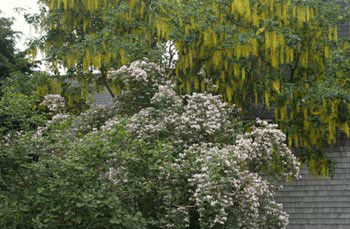
Often called the Golden Chain Tree, Laburnums are members of the Class Magnoliopsida (flowering plants) and the Family Fabaceae (legumes). Obovate (egg-shaped) and 12 to 15 feet in height, laburnum x watereri has alternate, trifoliate leaves (three leaflets) that are 1¼ to 3” long, bright green to blue-green in summer, with insignificant color in the fall. Stems and bark are olive green and smooth, while the older bark of the trunk becomes rough and sometimes fissured. The spectacular yellow “chains” (racemes) can be 10 to 20” in length and are composed of individual pea-like flowers attached by short flower stalks (pedicles) to a central axis (peduncle). The bloom time of these flowers is seven to ten days, before giving way to flat green pods that turn brown in the fall. All parts of this plant contain Cytisine, a toxic compound that is poisonous to people and livestock.
Although hardy in zones 5 through 7, and tolerant of a pH range of 5.5 to 8.0, a protected, well-drained site is necessary, as Laburnum x watereri is prone to sun scald and twig damage during severe winters. Twig blight and canker can be problematic as well. Propagation is possible using leaf-bud and root-cutting techniques or by growing from seed. Site requirements make this Laburnum a perfect specimen for growing in protected corners of buildings or by a patio where the spectacular floral display will be a springtime delight for anyone.
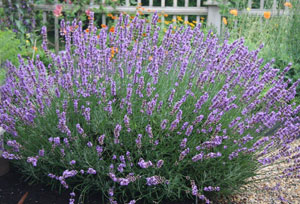 Carolyn Hollenbeck” width=”300″ height=”204″ data-id=”1109″> Lavandula angustifolia Carolyn Hollenbeck
Carolyn Hollenbeck” width=”300″ height=”204″ data-id=”1109″> Lavandula angustifolia Carolyn HollenbeckIn her design for the Terrace Garden, Beatrix Farrand edged the two center heather beds with Lavandula angustifolia. This ensured the visibility of these attractive plants from both the Farrand and Walter suites as well as from their study. L. angustifolia (previously classified as Lavandula officinalis) was the perfect choice for a Maine garden as it is the hardiest of the lavender species.
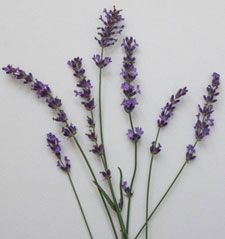 Carolyn Hollenbeck” width=”225″ height=”239″ data-id=”1110″> Lavender detail Carolyn Hollenbeck
Carolyn Hollenbeck” width=”225″ height=”239″ data-id=”1110″> Lavender detail Carolyn HollenbeckNative to the Mediterranean, Lavandula has been used since Greek and Roman times for cleansing, fragrances, and medicinal purposes. Although not native to England, monks documented its presence in monastery gardens during the Middle Ages. Called “true lavender,” the genus Lavandula belongs to the Lamiaceae family along with mint, thyme, and sage. Herbaceous to semi-woody, and maturing to 18 inches in height and width, it is often classified as a sub-shrub. Lanciolate to linear leaves are opposite to whirled. Tiny hairs covering new foliage give a gray-green color in summer, but the color changes to gray as leaves mature. Depending on the cultivar, flower spikes range from bluish purple to pinkish white.
L. angustifolia can be grown successfully in zones 5 to 7. They should be planted in full sun in well-drained light soil (pH 6.0 to 8.0). Shape small plants by pinching back the foliage, then prune older lavenders annually after flowering. Provide new plants with adequate moisture, but avoid overhead sprinklers that may cause the older shrubs to split open in the center. Be sure to test the soil before adding fertilizers. As lavenders do not come true from seed, propagate lavandula angustifolia by semi-hardwood cuttings in spring or fall. In cold climates, transplant in early spring. Note that late frosts can cause browning of stems and leaves, but plants should recover by early summer.
We can be certain, after a prolific career as a nationally recognized landscape gardener and designer, that Beatrix Farrand knew her plants intimately. Given her breadth and depth of experience, any plant (if only plants could feel) would be honored to rank among her favorites. But which one earned that truly special place in her heart? There is no shortage of plants from which to choose—perhaps one of the endless cultivars of iris, rose, clematis, or peony? Perhaps some attention-grabbing specimen that loudly announces its seasonal splendor?
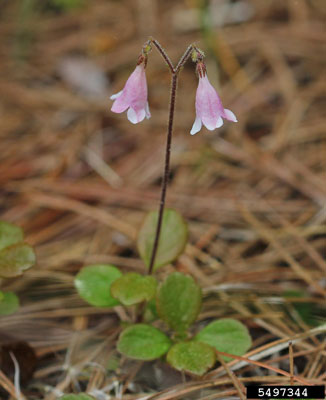
In fact, the evidence available to us today gives this distinction to the subtle and elegant twinflower (Linnaea borealis). In an interview published in the April 1962 edition of Flower Grower magazine, Amy Magdalene Garland recounted that twinflower was Mrs. Farrand’s favorite flower, which she enjoyed near the doorstep in her final garden in the twilight of her life. And why shouldn’t it be? This magnificent, well-behaved plant produces an attractive evergreen carpet of glossy, rounded leaves, punctuated in spring by a profusion of fragrant pink bells dancing airily in pairs atop long peduncles. Although it currently seems to be absent from Garland Farm, twinflower will no doubt find its way back to the dooryard garden during the long restoration to its historic character. Before moving to Garland Farm, Beatrix Farrand also grew twinflower collected from Mount Katahdin at Reef Point, her famous home for plants from around the world.
Mrs. Farrand was not alone in her love of twinflower. In all of his 18th-century explorations, the prolific Swedish botanist, Carl Linnaeus, found no plant that captivated him more. Today, it is difficult to find a portrait of Linnaeus without a hallmark sprig of twinflower clasped in his hand or affixed to his lapel. It is fitting, then, that this dainty resident of northern woodlands was eventually named Linnaea in his honor. The specific epithet is equally fitting, as borealis (Latin for ‘of the north’) could scarcely suit a plant more than it does twinflower. Indeed, the plant is found across the northern hemisphere, from boreal forests near the Arctic, southward to evergreen and mixed forests in parts of Europe, Russia, Alaska, Canada, and the contiguous United States, including the woods of New England.
Given the rich history of twinflower, and its magnificently understated springtime display, it certainly deserves our consideration for a spot in informal borders with partial shade. It is entirely at home in yards throughout New England, with cold hardiness never a concern. With a northern distribution in nature, summer heat may be a problem, so be on the lookout out for the punishing effects of intense summer sun and drying soils. Twinflower grows best in soils that closely match our native forest soils, which tend to be acidic. Other than that, twinflower should perform reliably in the garden, year after year. Oh, but there’s a catch—to grow it, you first have to find it offered for sale! Of course you are not likely to find it at the big box stores, but even many reputable garden centers are unlikely to carry it. Nurseries specializing in native flowers and woodland plants are your best bet. To prevent frustration, you’d best consider the challenge of the hunt as another aspect of this lovely plant that adds to its charm.
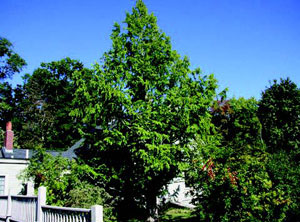 Carolyn Hollenbeck” width=”300″ height=”222″ data-id=”1112″> Metasequoia glyptostroboides Carolyn Hollenbeck
Carolyn Hollenbeck” width=”300″ height=”222″ data-id=”1112″> Metasequoia glyptostroboides Carolyn HollenbeckCommonly known as the Dawn Redwood, Metasequoia glyptostroboides was described in 1941 as a fossil from the Mesozoic era, but in1948 live trees, described by Hug and Cheng as “living fossils,” were discovered in China. After seeds were collected by the Arnold Arboretum, seedlings were distributed worldwide for trials. Today a magnificent specimen stands near the east side of the Terrace Garden for the enjoyment of visitors to Garland Farm. Another specimen, also formerly at Reef Point, now resides at Thuya Garden in Northeast Harbor, Maine.
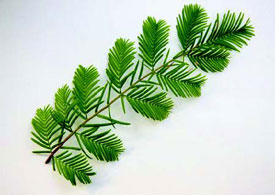 Carolyn Hollenbeck” width=”275″ height=”195″ data-id=”1111″> Leaf detail Carolyn Hollenbeck
Carolyn Hollenbeck” width=”275″ height=”195″ data-id=”1111″> Leaf detail Carolyn Hollenbeck
Metasequoia glyptostroboides is one of a few deciduous conifers. It is fast growing, pyramidal in shape, and requires little pruning. Hardy in zones 5 to 8 and requiring full sun and a moist, acidic, well-drained soil, the Dawn Redwood can reach heights of 75 to 100 feet. Trees have a distinctive buttressed trunk with shaggy, reddish bark. Its bright green leaves are one-half inch long, linear, flat, and opposite and held on deciduous stems. The opposite leaf arrangement distinguishes this tree from the Baldcypress (Taxodium distichum). In the fall, the color is reddish bronze.
The flowers are monoecious, with both male and female flowers appearing on the same plant. Female flowers are solitary and ovoid, becoming light-brown fruit, while male flowers are clustered and become dark-brown, round fruits. Propagation is accomplished from hard and softwood cuttings as well as by seeds that have been stratified. Metasequoia glyptostroboides may be susceptible to early frosts, and Japanese beetles and spider mites may be problematic. But other than these, the tree does not have many disease issues.
This “living fossil,” with its fascinating history and three-season interest, makes a lovely addition to any landscape with room enough to display it.

In early May visitors to Garland Farm are enchanted by the sight of the Sargent Cherry (Prunus sargentii) in full bloom. Located in the Entrance Garden and towering over the Farrand addition, this magnificent tree is listed in the Maine Register of Trees. Named for Farrand’s mentor, Charles Sprague Sargent (1841–1927), and native to Japan, Prunus sargentii is considered to be the hardiest of the cherry trees.
Useful in both home and urban landscapes, it thrives as a street tree, in buffer strips surrounding parking lots, and in highway medians. Beautiful structure, bark, spring flowers, and fall color provide four-season interest for gardens located in zones 5 through 8A. Its only requirements are full sun and an acid, well-drained soil. The dense canopy makes this a perfect shade tree.

Prunus sargentii belongs to Class Magnoliopsida and the Family Roscaeae and Subfamily Prunoideae. Growing to a height of 20 to 40 feet, the tree has a symmetrical canopy that can spread as wide as the tree is tall. The bark is an attractive polished cinnamon color, with prominent, horizontal lenticels. The showy, pink flowers on short pedicles bloom in spring before the new red-tinged leaves appear. The flowers give way to inconspicuous dark purple fruit that provides a summertime treat for birds. Shiny dark leaves, 2 to 5 inches long, are alternate, simple, and oval with serrate margins. Fall coloration ranges from yellow to orange and red.
Propagation of Prunus sargentii is possible from seed after two or three months of cold stratification or by softwood cuttings in spring or by half-ripe wood with a hell in summer. Pests of the tree include aphids, borers, scale, and tent caterpillars. The tree is also susceptible to Verticillium Wilt and will not tolerate smog. The longevity of this Champion tree at Garland Farm demonstrates its ability to withstand most of the issues that might affect this species.
Not only did Beatrix Farrand plant tiny Saxifraga x macnabiana in both the Terrace Garden and the Entrance Garden at Garland Farm, a voucher specimen in the Reef Point Gardens Herbarium collection confirms that it was at Reef Point also. Saxifraga x macnabiana, a small Alpine plant, belongs to the family Saxifragacaeae. The name Saxifraga, derived from the Latin saxum (rock) and frango (to break), refers to the ancient use of the plant to treat kidney stones. Saxifraga x macnabiana (MacNab’s Saxifrage) was an accidental cross discovered in the garden of horticulturist and botanist, James MacNab (1810-1878).
Saxifraga x macnabiana
 Carolyn Hollenbeck” width=”250″ height=”221″ data-id=”1114″> Saxifraga x macnabiana Carolyn Hollenbeck
Carolyn Hollenbeck” width=”250″ height=”221″ data-id=”1114″> Saxifraga x macnabiana Carolyn HollenbeckThe 2” rosette foliage of Saxifraga x macnabiana is evergreen, with thick tongue-shaped leaves. Edges are frosted with silvery marks of calcium carbonate filling the pores of the leaf margins. These leaf secretions are responsible for the name “encrusted” or “silver” Saxifraga. Highly perfumed, ½’ flowers have flat petals spotted with red flecks, rising 15” above the basal foliage.
Saxifraga x macnabiana is difficult to locate or propagate. Even under good growing conditions, erratic seed germination may take up to 60 days and then may not come true. Propagation from offsets or division is another option. Specimens should be planted in sandy loam mixed with peat and grit. Borders, rock gardens, or containers are suitable site locations. Soil must be moist at all times, but avoid overwatering. Bright light is needed, yet hours of direct sunlight should be limited. Pests of Saxifraga x macnabiana include spider mites, whitefly, and mealy bugs.
Although challenging to grow, Saxifraga x macnabiana is a beautiful little plant to discover in a garden. Farrand planted it next to the path in the Entrance Garden and outside the door of her suite in the Terrace Garden, where she could easily see it. At Reef Point, however, the small plant was located next to the Gardener’s Cottage, allowing others the opportunity to enjoy MacNab’s Saxifrage.
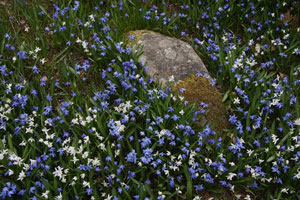 Carolyn Hollenbeck” width=”300″ height=”200″ data-id=”1117″> Scilla siberica Carolyn Hollenbeck
Carolyn Hollenbeck” width=”300″ height=”200″ data-id=”1117″> Scilla siberica Carolyn HollenbeckSpringtime at Garland Farm brings color back to the grounds with the emergence of many small bulbs. Winter Aconite, Snowdrops, and Chionodoxa appear at the end of March, but by late April, the carpet of Scilla siberica in the entrance garden puts on a show that should not be missed.
Scilla siberica, under cultivation since 1796, originated in Russia and Eurasia. Hardy in zones 2 to 8, these bulbs thrive in rich soils that have good drainage. Classified as a “true bulb,” S. siberica has five major parts: a basal plate from which the roots grow, fleshy scales serving as storage tissue, a tunic, or skin-like covering, protecting those scales, a shoot consisting of the developing leaf buds and flowers, and lateral buds which develop into bulblets.

Scilla siberica produces nodding blue or white flowers on stalks that arise from the center of a rosette of narrow, dark green foliage. A single flower up to 1” wide or a raceme of two to three flowers appear on the stalk. Flowers have six tepals (petals) with blue anthers. On blue flowers, a single dark blue vein runs down the middle of the tepal. Pollinators are attracted to the little flower, and if fertilized round seed capsules are produced, yielding reddish-brown seeds. Lateral buds offer a second method of propagation. It should be noted that all parts of this plant are poisonous.
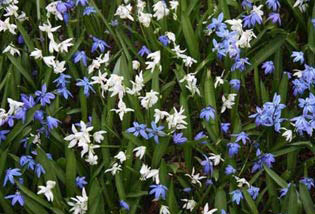
For maximum effect, plant S. siberica in masses during the fall months. Full to part sun is required, but early flowering of these spring bulbs allows us the ability to naturalize them in deciduous woodlands, enjoying the blooms prior to the trees leafing out and casting shade on the ground. Planting them along walkways or paths allows full appreciation of their beauty and fragrance, a welcome ght after the long winter months have passed.
 Pressley Associates, Inc.” width=”225″ height=”297″ data-id=”1141″> Stewartia Tree at Garland Farm Pressley Associates, Inc.
Pressley Associates, Inc.” width=”225″ height=”297″ data-id=”1141″> Stewartia Tree at Garland Farm Pressley Associates, Inc.One of the more fascinating trees at Garland Farm is the Stewartia koreana, with its lovely exfoliating bark, attractive white flowers, persistent seed capsules, and good fall color. Since the tree is located adjacent to the garage and next to the driveway, it is visible from the Farrand addition, the barn, and the field beyond that was once the Garlands’ vegetable garden.
Stewartia koreana was introduced to the west from Korea (where it is called the silk tree) in 1917 by the famed plant collector Ernest Henry Wilson. The tree, which is classified as a member of the Family Theaceae and the Order Ericales, is deciduous, oval to pyramidal in shape, and has upright spreading branches.
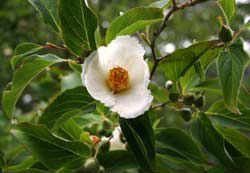 Carolyn Hollenbeck” width=”250″ height=”173″ data-id=”1140″> Stewartia koreana’s flower and buds
Carolyn Hollenbeck” width=”250″ height=”173″ data-id=”1140″> Stewartia koreana’s flower and budsCarolyn Hollenbeck
A mature specimen grows 20 to 30 feet high. Its leaves are bright green, alternate, and simple with fine serrations. Fall color ranges from purple to orange or red, but a few specimens exhibit little coloration. The three-inch flowers are white with yellow stamens and five or six concave petals. Since they open over a long period of time, it is possible to observe bud, flower, and capsule at the same time. They are flattened compared to those of S.pseudocamellia koreana (Japanese Stewartia), which are more cupshaped, a characteristic that aids in differentiating the two species that share similar characteristics.
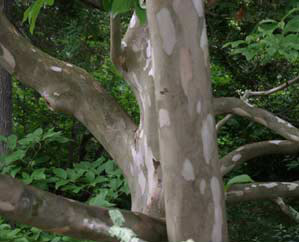 Carolyn Hollenbeck” width=”299″ height=”242″ data-id=”1139″> Stewartia koreana exfoliating bark Carolyn Hollenbeck
Carolyn Hollenbeck” width=”299″ height=”242″ data-id=”1139″> Stewartia koreana exfoliating bark Carolyn HollenbeckThe flowers give way to a pointed, five-valved fruit capsule that becomes triangular and reddish brown when mature. The distinctive bark of the S. koreana is smooth underneath, ranging in color from a light gray to an orangebrown. All these colors may be present on the same tree, with older bark exfoliating and flaking off in irregular pieces.
The tree requires sun with some shade and an acidic soil that is moist, cool, well-drained, and high in organic matter. S. koreana, which is hardy in zones 5B through 7, offers a high degree of pest resistance, but is often difficult to propagate and to transplant. Propagation can be accomplished from softwood cuttings or from seeds. Some sources suggest that the seeds require a double dormancy to germinate and if they do germinate, the viability rate is low. Softwood cuttings are a challenge to root and need to enter dormancy before transplanting. Once established, however, S. koreana requires little maintenance other than occasional pruning of lower limbs to expose more of the fine bark. To compare the various trees, visit the national collection of Stewartias held at the Polly Hill Arboretum in West Tisbury, Massachusetts.
